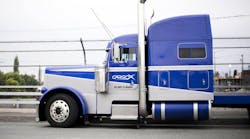With the high costs of operating a trucking company coupled with 2023’s—and now 2024’s—low rates, fleets are looking for savings where they can. Many are employing technology that helps increase fuel and operational efficiency, but others, like CargoX, have found some relief by switching insurance carriers.
Commercial truck insurance costs can range anywhere from $1,000 to $20,000 annually per unit. Additionally, insurance costs can have a greater negative impact on smaller fleets than on larger ones. According to the American Transportation Research Institute, small carriers paid between 1 and 4 cents more per mile than large fleets on their insurance premiums. RTS Financial Services reported a similar finding, stating that small carriers—fleets of 10 trucks or fewer—spend 33% more on insurance premiums than larger carriers, on average.
CargoX is an owner-operator carrier with 22 trucks in the Midwest. Its founder, Djuro “DJ” Kolundzija, said he decided to switch insurance providers mostly because of costs. He chose HDVI, which brands itself as a technology-first trucking insurance company. It saved CargoX $100,000 in costs and improved his fleet’s safety scores.
See also: How carriers can best manage insurance costs and risks in 2024
HDVI uses fleet data to assess, improve fleet risk
HDVI was founded on the idea that the trucking insurance industry is “broken,” according to Mark Brest, HDVI fleet services operations manager. The industry has seen premium increases across the board, even for high-performing fleets and those that integrate advanced driver assistance systems.
“Trucking companies need relief,” Brest said. “Really, that's what makes HDVI unique.”
The company uses a proprietary underwriting system that he said leverages telematics systems and artificial intelligence data to rate fleets and their performance more accurately with a “high-definition view” to offer customers a personalized rate.
Implementing HDVI and its data capture provides an “opportunity to not only improve insurance, pricing, and make it more accurate but also at the same time help fleets like CargoX save money and help them improve efficiency as well,” Brest said.
Any truck insured by HDVI must have an installed telematics system and forward-facing dash camera. Brest told FleetOwner that HDVI can easily integrate with most telematics providers, from the “big names” to the smaller providers. For fleets that don’t already use a telematics system, HDVI can help with that as well.
“We'll actually pay to outfit their fleet with the road-facing dash cameras, so it really helps break that barrier down for fleets that can't necessarily squeeze that into their budget,” Brest told FleetOwner.
This was the case with CargoX, which only had ELDs in its trucks prior to HDVI.
See also: FMCSA revokes five registered ELDs
How HDVI can help with insurance premiums, fleet performance
With permission, HDVI views a trucking company’s telematics data 90 days before they begin coverage and assesses performance and risk. HDVI will use that data to lock the fleet into a policy. Brest said this policy rate will never increase.
However, there are ways that a fleet can lower their rate through discounts—even throughout their coverage period. When under the HDVI Shift policy, which captures data and runs predictive crash models, fleets that continue to practice safe driving can save up to 20%, Brest told FleetOwner.
Although HDVI is an insurance provider, it can help fleets address the costs associated with unsafe and aggressive driving. These include costs such as the wear and tear associated with hard braking, speeding violations, increased fuel consumption, and more.
The company also provides insights on the thousands of data points it captures to improve other aspects of the business, displaying them in a manager dashboard known as the HDVI Fleet Portal.
“If you can't measure something, you can't improve it,” Brest said. “That's really what makes HDVI so special is our ability to take the complexities of the hundreds of thousands of data points that come from these ELDs and the telematics devices, and then we display them in simple, easy-to-understand views.”
This fleet portal allows fleet managers to view their insurance rates, the status of discounts, and driver-level and fleet-level safety metrics. Managers can also view which drivers impact their insurance rates the most with specific suggestions to help them improve, Brest told FleetOwner.
Along with the portal, each fleet receives a regular call from a member of the HDVI Fleet Services Team. This one-on-one meeting covers fleet metrics, what a fleet is doing well, what a fleet can improve upon to improve its rate, and its overall safety and efficiency.
Improving fleet metrics by switching insurance providers
Kolundzija said switching to HDVI helped CargoX save roughly $100,000 in insurance costs across the fleet. He’s also seen performance improvements of 20 to 30%. The CargoX safety score from its telematics provider has also increased by about 20 points since switching to HDVI.
See also: Fleets face social inflation and high insurance costs, but they have some control
Furthermore, CargoX drivers delivered little to no pushback when implementing HDVI and dash cameras into the fleet. Kolundzija said that many drivers already had their own simple dash cameras installed, so they had “no issues” receiving a free one to help keep them protected in the event of a collision. He also mentioned another event where CargoX was able to provide coverage of a crash to a police officer on the scene to prove that the truck driver was not at fault.
“Things like that really go very far,” Kolundzija told FleetOwner. “I would never run a fleet without the telematics and without the cameras again.”
HDVI recently celebrated a milestone of more than 100% year-over-year growth in 2023, with nearly 200 million miles of safe driving and $1.1 million saved in insurance premiums for its customers.





